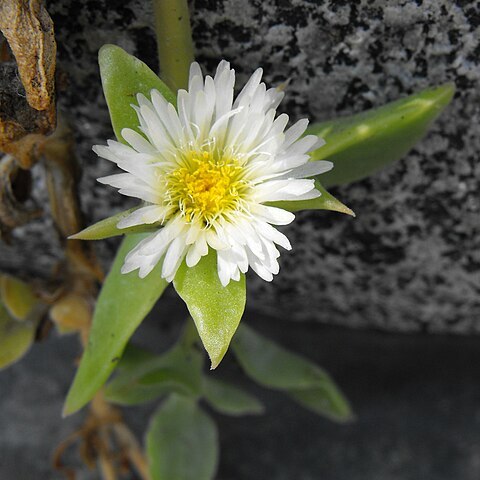A glabrous herb. Branches elongated, procumbent, sometimes rooting at the nodes, up to 40 cm long or more, the internodes 2 to 6 cm long. Leaves spreading, connate at base, ovate-lanceolate, oval, ovate, and broad-ovate, somewhat cordate at base or, more rarely, slightly tapering, acute or obtuse, fleshy, very smooth, dull green, 2 to 5 cm long, 1.5 to 3 cm broad. Flowers usually solitary, occasionally 2 to 3-nate, open in the middle of the day, 2.5 cm in diameter. Peduncle usually 3 to 5 mm long, rarely up to 1.5 cm long. Receptacle short, saucer-shaped, laterally compressed. Sepals 5, unequal in length, 3 acutely keeled, up to 1.2 cm long, 8 mm broad, all caudate, the shorter ones with broad membranous margins, 5 to 7 mm long. Petals numerous, crowded, 3 to 4-scriate, linear, slightly tapering downwards, obtuse, 0.7 to 1.2 cm long, 1.5 mm broad. Stamens at first collected in a cone, soon almost erect, 5 mm in diameter, surrounded by filiform staminodes; filaments white, the inner bearded, 3 to 5 mm long; anthers and pollen yellow. Disk composed of 5 separate glands. Ovary inferior, conspicuously elevated above and 5-lobed; stigmas 5, subulate, 2 mm long. Capsule expanded 2 cm in diameter, 5-celled; keels almost contiguous, and entirely so when the valves completely recurve after prolonged soaking; wings of the loculi very narrow; seeds roundish, minutely tuberculate.
More
Perennial, dwarf shrublet, up to 0.1 m high, stems decumbent, rooting at nodes. Leaves smooth, oblong-ovate, acute, flat on top or slightly concave in middle, bladder cells flat. Flowers solitary, occasionally 2-or 3-nate, deep purple. Flowering time spring to late summer. Capsules pale brown, 5-locular, closing bodies absent, covering membranes reduced to a narrow ledge, valve wings narrow.
Leaves united into a 3–4 mm. long sheath; lamina 20–30 × 10–17 mm., ovate, fleshy, tapering to terete at the base, light green, very finely papillose, upper surface flat, the midrib often furrowed, the lower surface indistinctly keeled.
Freely branching low perennial with branches and branchlets creeping and rooting at the nodes, stem with a light grey-brown membrane when young; young shoots green, finely papillose, internodes c. 20 mm. long.
Flowers c. 15 mm. in diameter, solitary, lateral, subsessile, white.
Perianth-segments unequal.

